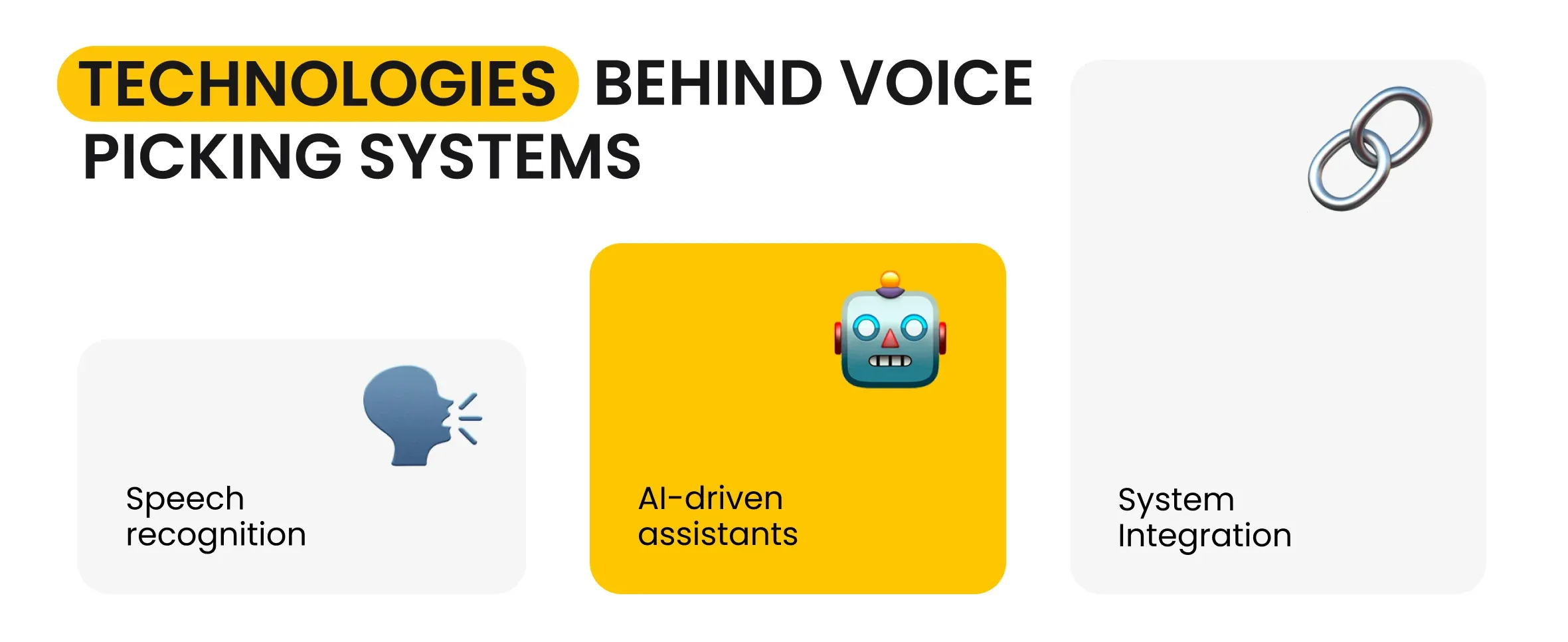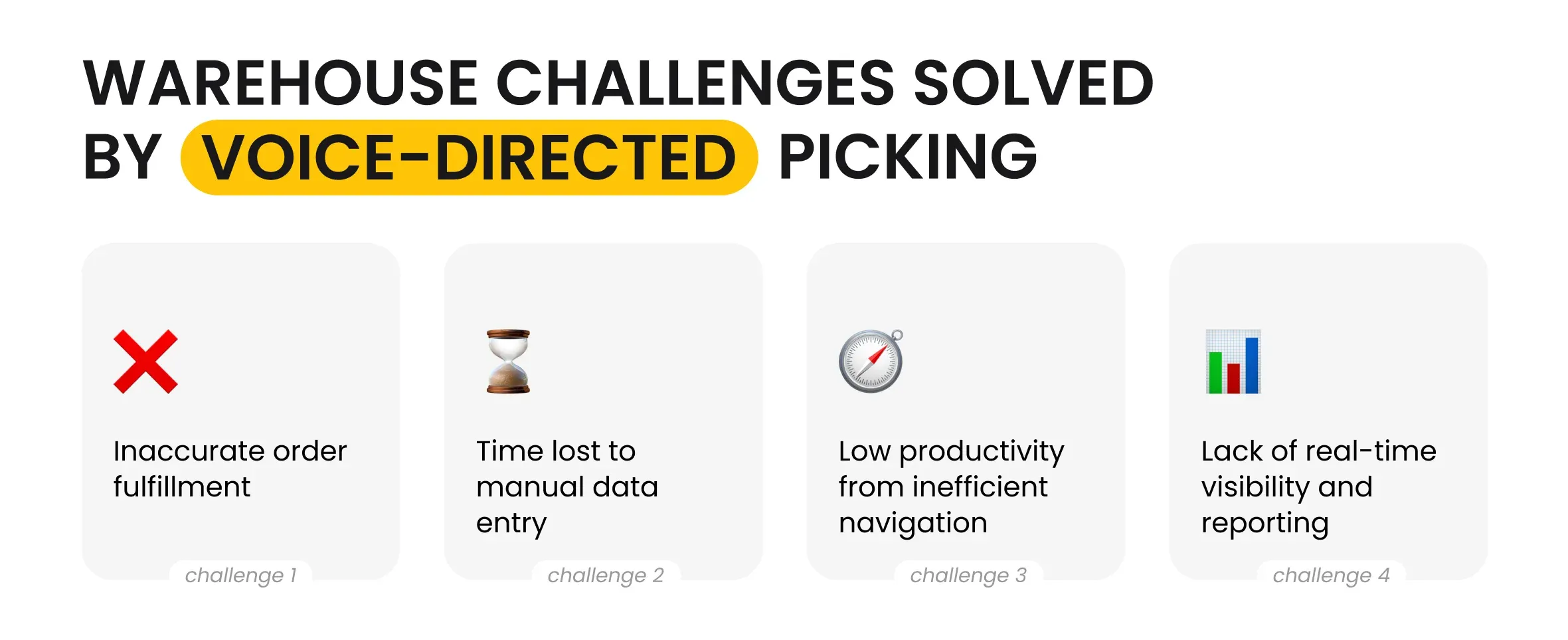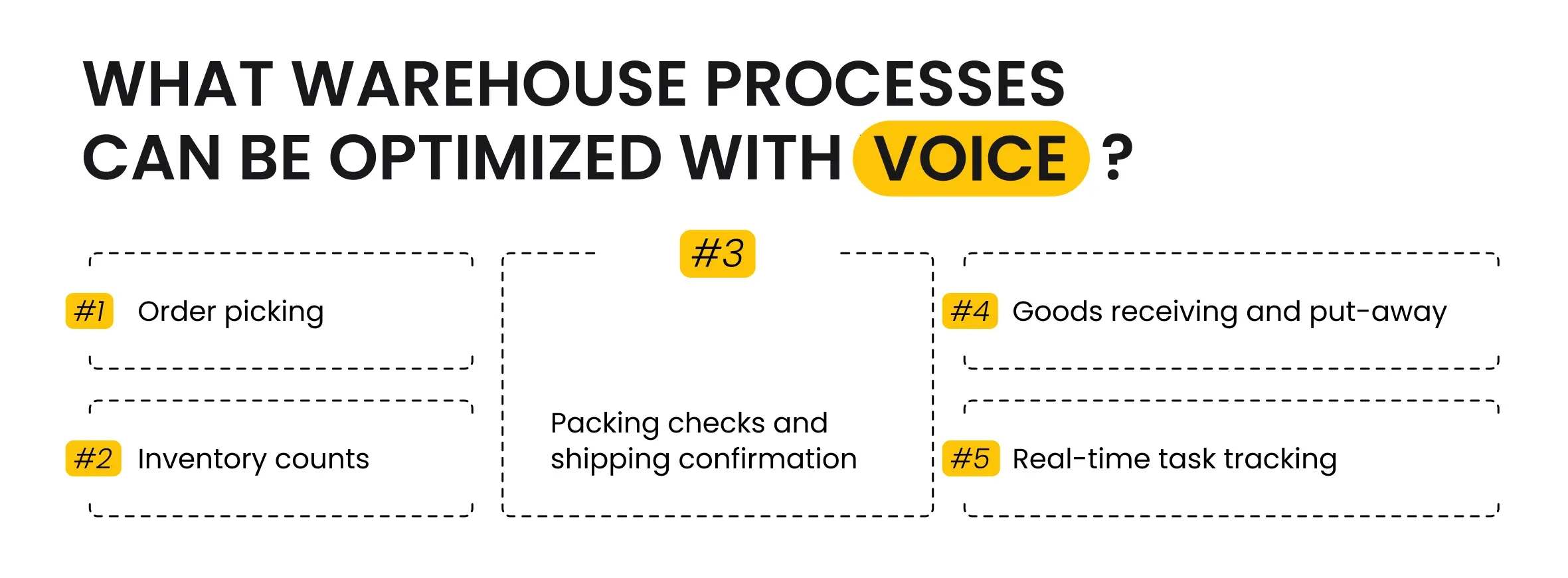Supply Chain
How a Voice Picking System Can Revolutionize Warehouse Operations?
May 15, 2025 • 132 Views • 15 min read
Bohdan Vasylkiv
CEO & Co-Founder
Have you heard of a warehouse voice picking system? Or are you considering integrating one into your warehouse systems, but don’t understand how it can enhance your business operations?
In this article, we will answer all the foregoing questions, explain how voice-operated warehouses work, and consider the most prominent advantages of such software.
How Does a Voice Picking System Work?
Let’s start with the basics. So, what exactly is a voice picking system, and how does it work?
Long story short, it is software technology designed and developed specifically for warehouse management or other operations within the supply chain industry. Surprisingly, as of 2024, this software solutions market was estimated at just around 5.7 billion US dollars. Still, it is expected to grow to almost 25 billion US dollars in the next ten years.

Nevertheless, many modern logistics companies and warehouse owners commonly utilize these voice-operated systems to achieve higher efficiency and safety as well as, at least partly, boost different warehouse operations.
Voice picking system requires three separate technological solutions to work:
- Speech recognition software
- Management system integration
- Built-in virtual assistant
1. Speech Recognition
This solution must distinguish human speech and process it, learning and answering the employee’s requests.
However, to make it “hear”, the warehouse team should also use specific hardware solutions like microphones. Fortunately, modern speech-recognition software solutions for supply chains can be used without the whole team having to buy headsets. For instance, you can allow employees to use their smartphones or other devices for the same purposes.
2. System Integration
Your warehouse voice picking system must recognize voice commands and be integrated into other management systems, such as the overall Supply Chain Management (SCM) or Warehouse Management System (WMS). Otherwise, your voice recognition software will only be able to understand the demand.
One core goal of integrating such solutions into your warehouse management is to provide employees with more flexible and convenient operational methods, such as performing different tasks using only their voice. Such operational flexibility helps to boost your workers' efficiency and even safety.
Basically, with such software on board, they can perform some routine tasks hands-free and with their eyes up, staying more aware of their surroundings and being able to perform a few tasks at once.
However, to enable such a feature, you must ensure it can be implemented within your existing WMS or other management software and find an appropriate team that offers voice recognition software development services for your industry.
3. Virtual Assistant
Finally, apart from transcribing speech to text and sending it to your system, WMS voice picking requires a built-in intelligent assistant, capable of processing input data (transcribed speech) and performing demanded commands.
Previously, designing and developing such solutions was a challenge, requiring businesses to hire data engineers and experienced software developers familiar with both such technologies and the business industry. Nowadays, such solutions are much easier and affordable, allowing companies to integrate numerous ready-made software and even full-fledged artificial intelligence.
Long story short, modern software solutions can boost such functionality and make it even more flexible. For instance, do you remember those robotic calls from your bank or some delivery services, when an artificial voice asked you to press certain buttons for different tasks like approving a transaction?
Those are chatbots, which were considered new-era instruments not long ago. However, their functionality was limited and “hard-coded,” i.e., they could understand only a few programmed commands.
Let’s say the developers designed an approval as “Okay”. Old chatbots won’t understand other words like “Approve” or “Agree”, so the user was limited to a single option. It is not a big deal when it comes to simple transaction verification. Yet, when it comes to warehouse and inventory management, hard-coded commands can become a real stress:
“Okay, add an item with a label №17-22-3405 to a list “Delivery” and remove the item with a label №17-22-3405 from a list “Ordered”, then add the item with a label №17-22-3405 to “Restock”. Imagine repeating this process throughout the whole day!
Fortunately, modern AI solutions with built-in natural language processing models can understand synonyms and regular speech, simplifying the foregoing process to just:
“Add an item 17-22-3405 to delivery and restock lists and remove it from others”. Do you also feel relieved?
Modern technologies can help boost the performance of your warehouse employees without making them uncomfortable or requiring them to remember all protocols and templates to perform simple tasks. Besides, many such NLP-driven AI solutions are cheap. They can be easily integrated into your business operations to streamline repetitive tasks, helping to save time and resources, and solve many common warehouse management challenges.
Real Warehouse Challenges Solved by Voice-Directed Picking

Apart from offering hands-free inventory management and automating this process, voice-directed warehousing helps to deal with:
- Inaccurate order fulfillment
- Time lost to manual data entry
- Low productivity from inefficient navigation
- Lack of real-time visibility and reporting
Inaccurate Order Fulfillment
Frankly, AI-driven voice recognition picking is also hard-coded. However, in these cases, software developers define the core operations to be performed, not the commands themself.
For example, developers or prompt engineers define a virtual assistant's tasks regardless of the triggering phrase. As a result, such a system can help businesses avoid potential mistakes or other issues. Besides, integrated virtual assistants can ask employees or clients to repeat themselves if the command seems wrong or the speech isn’t clear.
Time for Manual Data Entry
One of the core reasons to invest in such voice-operated technologies is the possibility of saving your employees’ time.
As we mentioned before, when your staff uses voice commands for warehouse management, they are hands-free. In other words, they can multitask while updating the inventory or performing other warehouse operations. For instance, your employees can look for different items or pack and reorganize the parcels while speaking.
Moreover, telling something is always faster and more convenient than writing or manually updating on the device.
Low Productivity and Navigation
Yet another advantage of voice-directed warehousing is extra features. For example, a built-in voice assistant can be used to update data about available items or change their status and notify or navigate employees during work.
Data access is reversible and can also help your on-premises staff, guiding them around the warehouse, explaining where to find certain goods, or updating and notifying employees on upcoming events like the nearest restocking or package departure.
Real-Time Visibility and Reporting
Continuing the foregoing, voice picking systems can boost the real-time awareness of the ongoing operations or upcoming events.
First, employees can notify the team about something happening. They can also use it for real-time inventory and warehouse management reporting, speeding up the overall data update process.
At the same time, the system can automatically notify staff about all the updates or events. To make it even more convenient, you can ask developers to set up more flexible or customizable systems, allowing for sorting employees by departments or tasks, enabling in-team communication, etc.
What Warehouse Processes Can Be Optimized With Voice?

Apart from challenges, the voice picking system can be used for process optimization, or even as one of the steps for full-fledged AI warehouse automation. Talking about the process automation, it is possible to highlight a few core warehouse management operations like:
- Order picking
- Inventory counts
- Goods receiving and packaging
- Real-time task tracking
- Packing checks and shipping confirmation
Order Picking
Voice-operated warehousing is an excellent way to optimize and speed up order picking. Using such technologies, your employees can perform all operations by reporting their progress by voice and listening to the system's instructions on where to find other items to pack or other guides on packaging-related operations.
Order picking optimization is the core purpose of voice-directed warehousing, which also covers many related operations and processes.
Inventory Counts
This technology can improve inventory management and streamline operations, such as inventory counts. It is a rather optional yet highly beneficial feature.
As mentioned before, artificial intelligence is one of the core modern technologies behind voice picking software. This means you must spend time integrating AI and setting it up. So, why won’t you benefit the most, considering the most time-consuming and resource-intensive part is already included?
You can spend some more resources to adjust and train your background AI model to perform additional steps like counting the items, or even making demand forecasting, based on your storage data, which a virtual assistant will have access to anyway.
Goods Receiving and Packaging
Another way to upscale inventory management services with voice-operated systems is to use them when receiving or packaging goods. Such functionality requires item counting, order picking, and a few extra settings to work. As a result, inventory management is much easier, faster, and more accurate.
Real-Time Task Tracking
Finally, voice picking systems can and should be used to track real-time tasks and progress updates.
Being able to update statuses with voice, without using any other systems or methods, makes the work more seamless and allows staff to concentrate more on their tasks, not their work updates.
Packing Checks and Shipping Confirmation
Once again, in addition to using voice commands during routine check-ups or similar assignments, employees should use the same functionality when interacting with freight forwarders, whether receiving or sending goods.
Such technologies are especially beneficial during such activities, allowing warehouse staff to free their hands and concentrate on package inspections instead of checking the list.
The Future of Voice Picking Technology in Warehouse Management
It is surprising how unmonetized the voice picking system development market is, considering all the features and benefits of such functionality. Still, explaining such low monetization (5.7 billion US dollars) might be possible with the relative simplicity of designing and developing such systems.
Many companies also look for ways to avoid hiring a bespoke software development company to maintain a full-fledged software development project. However, such “solutions” commonly lack accuracy and efficiency, mostly being group voice chats on third-party services. Not to mention the security threats such approaches might bring.
Judging from our experience, integrating voice-picking technology in warehouse management operations is worth consideration, and we hope such services will become more appreciated and recognized soon due to the advantages they offer.
What’s your impression after reading this?
Love it!
1
Valuable
1
Exciting
1
Unsatisfied
1
FAQ
Let us address your doubts and clarify key points from the article for better understanding.
Can voice picking systems be integrated with my current WMS or ERP?
Yes, most voice picking systems can be integrated with existing WMS or ERP systems through APIs or middleware solutions.
What are the challenges of integrating voice-directed warehousing systems?
Challenges include system compatibility, data synchronization, employee training, and initial setup costs.
How long does it take to implement a voice picking system?
Implementation can take a few weeks to a few months, depending on system complexity and integration requirements.
How secure is the data in a voice directed system?
Data in voice-directed systems is generally secure, with encryption and user authentication, but security depends on the provider and implementation.
you may also like
Let’s talk!
This site uses cookies to improve your user experience. Read our Privacy Policy
Accept
Share this article